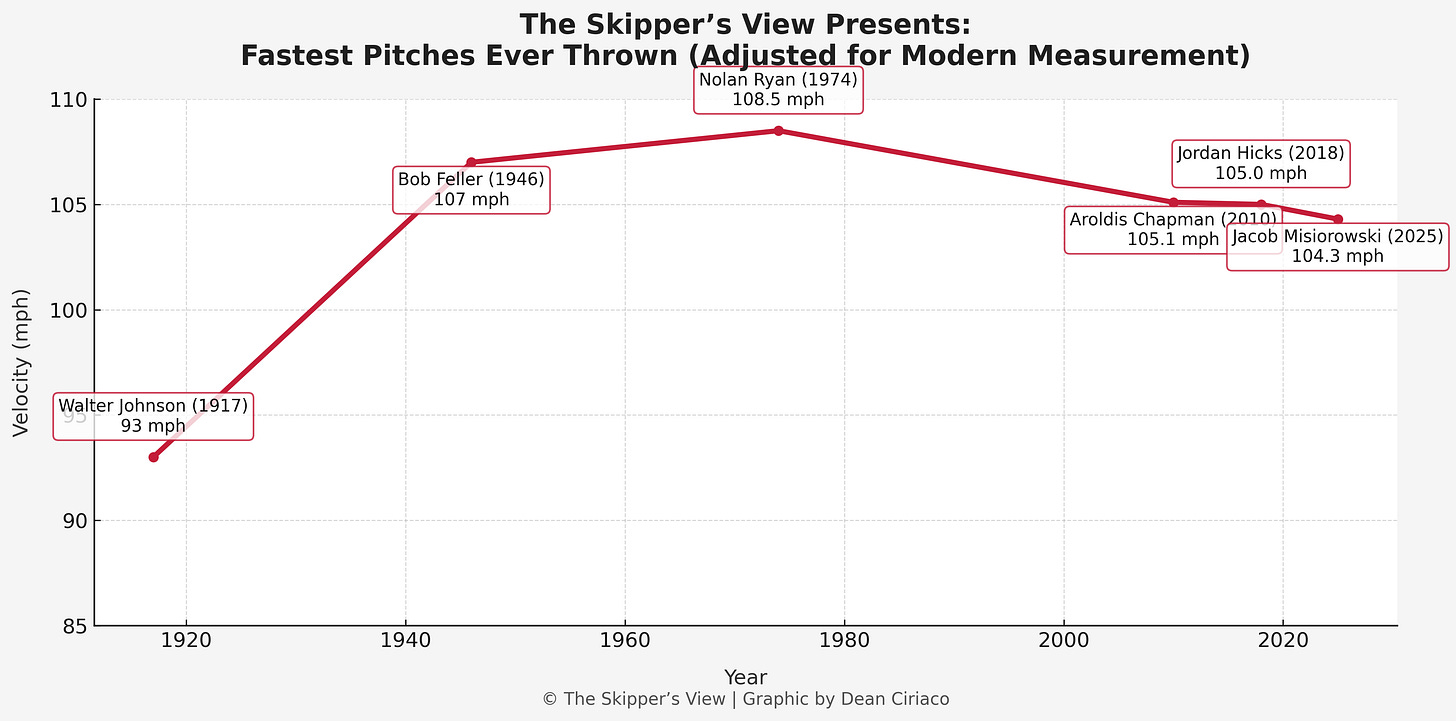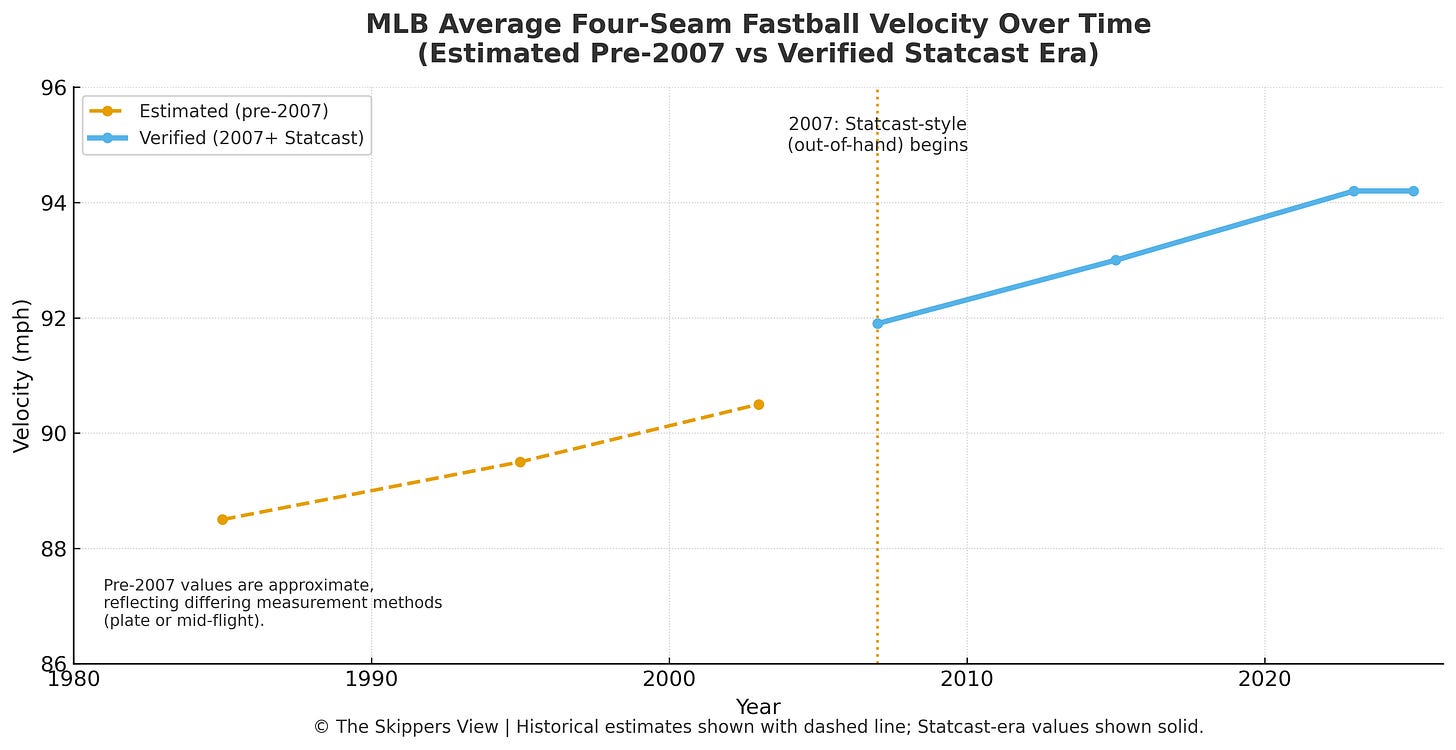The crowd at American Family Field was still buzzing after last night’s game. Milwaukee Brewers rookie Jacob Misiorowski had just unleashed an awe-inspiring display of raw pitching power. The 23-year-old came out of the bullpen in the 3rd inning, throwing pure heat, repeatedly lighting up the radar gun at 102–104 mph. Misiorowski fired 31 of his 57 pitches at 100+ mph, including a pair that topped 104.2 mph. So, it made me think– How fast can a human being really throw a baseball?
From Feller to Ryan:
Triple-digit fastballs might seem like a modern phenomenon. And while for the most part it is, baseball’s obsession with velocity goes back generations. History is full of pitchers who were ahead of their time, throwing so hard it seemed to defy physics.
Take Bob Feller, the Cleveland Indians fireballer of the 1940s. In an era before radar guns, Feller’s fastball was literally measured by racing it against a motorcycle. The results? His pitch beat the bike, clocking at nearly 100 mph on outdated equipment. Decades later, when physicists reanalyzed the test, they estimated that his actual release velocity might have been around 107 mph.
Fast forward to 1974, when Nolan Ryan’s fastball registered 100.8 mph near home plate. But because radar then measured velocity late in flight, analysts now estimate that Ryan’s pitch left his hand at over 108 mph. In other words, Ryan and Feller might have been throwing harder than anyone in the Statcast era.
It’s a humbling reminder: for all our modern advancements, the human arm has been flirting with the same upper limits for a century. Chapman’s 105.1 mph pitch in 2010 remains the fastest recorded in MLB history, but adjusted data suggests Ryan and Feller’s best efforts were right there. The difference today isn’t that pitchers are faster – it’s that more pitchers can approach that speed.
In 2002, the average MLB fastball sat around 89 mph. In 2025, it hovers near 94. Nearly every bullpen features at least one pitcher capable of touching 100 mph. The radar readings may be modern, but the race to the edge of human performance is timeless.
The Science of Speed: How Pitchers Generate Triple-Digit Heat
So how exactly does a human being launch a baseball at over 100 mph? It’s all about biomechanics, the seamless coordination of muscles, joints, and timing that transforms stored energy into explosive motion.
At its peak, a professional pitcher’s shoulder can internally rotate at over 7,000 degrees per second—one of the fastest recorded human movements. The torque on the shoulder and elbow often surpasses 100 Newton-meters, roughly like the force of a 60-pound weight dangling from your hand during the forward whip.
From windup to release takes less than two-tenths of a second. The baseball goes from stillness to 100+ mph in the blink of an eye.
Of course, all of that comes at a cost. Every pitch at maximum effort flirts with the breaking point of human anatomy. The ulnar collateral ligament (UCL) in the elbow is especially vulnerable. The forces generated by elite pitchers are roughly equal to the ligament’s failure threshold, which is why Tommy John surgeries have become so common. Throwing a baseball that hard is not something the human body was built to do often.
Why 103+ MPH Fastballs Are So Rare
Simple: We are human.
Given the incredible strain on the body, it’s no wonder that 103 mph seems to be the number few can touch. Biomechanics experts like Dr. Glenn Fleisig of ASMI believe we’re already near the physical ceiling of human throwing velocity. He and others estimate the theoretical maximum for a human fastball to be somewhere between 108 and 110 mph.
Why the limit? Muscles can be trained, but ligaments and tendons can’t be meaningfully strengthened. The UCL and the shoulder capsule are the weak links in the chain. Push harder, and they fail. Every additional mile per hour requires exponentially more force, but the body can’t withstand that force indefinitely.
The numbers bear it out: as average velocity has climbed, so have arm injuries. In the past two decades, the rate of Tommy John surgeries has more than doubled. The relationship is simple — throw harder, get hurt faster.
There may be rare exceptions. Stories persist about minor-league legend Steve Dalkowski, who was reportedly throwing 110 mph in the 1960s, although no verified data exists. Modern athletes like Jordan Hicks and Ben Joyce have also reached speeds of 104–105 mph. But beyond that range? No one has sustained that rate of speed without injuring themselves and or being so erratic that it is dangerous to put them on the mound.
So while it’s fun to dream about a 110 mph fastball, the reality is that we may have already hit the human threshold. Any higher, and the arm might come apart. Unless….. Science.
Pushing the Edge: The Future of Velocity
Still, baseball’s velocity revolution is far from over. While the upper limit hasn’t changed significantly, the number of pitchers operating near it has increased substantially due to new training philosophies and advancements in technology.
Today’s pitchers train more like sprinters and powerlifters. They use weighted balls, high-speed cameras, and motion capture to refine mechanics down to the millisecond.
Players like Misiorowski are products of this new era. They’ve been tracking spin rate, hip-shoulder separation, and elbow torque since high school. Tools like Rapsodo and TrackMan give instant feedback, allowing pitchers to fine-tune their movement patterns.
At the same time, the field of recovery science has undergone significant improvements. Modern training places equal emphasis on arm care and rest, utilizing sensors and workload monitoring to prevent overuse injuries. This has, of course, come with plenty of criticism. Rarely do we see pitchers exceed 110 or even 100 pitches in a game anymore. Even if they are dealing, managers will go out and pull the plug. To keep them healthy, they need to.
There are groups within the baseball community that aim to throw a baseball beyond 108 mph consistently. To do that, training is rapidly shifting from the realm of raw genetic talent to the domain of data science and artificial intelligence.
According to Jimmy Buffi’s simplified physics-based model—which treats the pitching motion as a kinetic chain of sequential energy transfers akin to collisions between body segments—a 200-pound pitcher generating 500 pounds of ground force with 85% efficiency could theoretically achieve a fastball velocity of up to 125 mph under perfect conditions. Unlocking this potential demands mechanical precision far beyond what the naked eye can detect, making AI an essential tool for identifying and fixing the subtle inefficiencies that distinguish top pitchers from this theoretical human peak.
The motion of pitching is so fast that it is very difficult for coaches to help pitchers make tweaks that will push the human body to the point where it could throw 110mph. This is where AI provides an advantage.
A revolution in sports science is being driven by portable, markerless motion capture systems that use AI and high-speed cameras to generate precise 3D biomechanical data in any setting. Companies like KinaTrax, Uplift AI, and 3motionAI have developed platforms that are validated against traditional, lab-based marker systems, making elite-level analysis accessible to a wider range of athletes.
These systems feed a torrent of data into powerful AI-driven analytics platforms, such as those pioneered by Driveline Baseball and BullpenAI. The AI analyzes dozens of metrics that are critical to velocity but invisible in real-time, including:
Kinematic Sequencing: The precise timing of pelvic, torso, and arm rotation to ensure an efficient transfer of energy. An inefficient sequence forces the arm to do more work, thereby leaking velocity and increasing the risk of injury.
Joint Angles and Velocities: Quantifying key performance indicators like peak shoulder external rotation, elbow flexion, and forward trunk tilt at ball release.
Hip-to-Shoulder Separation: Measuring the angular difference between the pelvis and torso, which creates elastic energy in the core that is violently released to generate rotational power.
This in-depth analysis enables the creation of highly personalized training programs. Instead of generic drills, a pitcher receives a regimen tailored to correct their specific mechanical flaws.
The integration of AI creates a powerful cybernetic feedback loop for athlete development. The process becomes a precise, iterative science:
Diagnose: An AI-powered motion capture session identifies a specific biomechanical inefficiency (e.g., slow trunk rotation).
Prescribe: A personalized training program is generated to target that specific weakness, focusing on drills and strength exercises to improve explosive rotational power.
Train & Monitor: The athlete performs the training while wearable sensors track workload and physiological response, ensuring they are adapting and recovering properly.
Re-Diagnose: A follow-up biomechanical analysis quantifies the improvement in trunk rotation speed and its effect on ball velocity.
This cycle of diagnose -> prescribe -> train -> monitor -> re-diagnose allows coaches and athletes to make objective, data-driven adjustments. It transforms the art of coaching into a scientific process, systematically eliminating the inefficiencies that prevent a pitcher from reaching their physical ceiling. The path to 108 mph and beyond lies not just in making athletes stronger, but in utilizing AI to optimize their biomechanics, enabling them to safely and efficiently approach the theoretical 125 mph limit of human potential.
If you haven’t already, please consider subscribing below!




